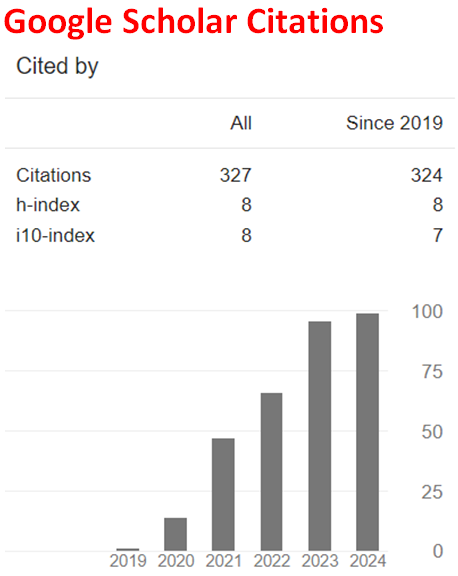Proximate and Selected Mineral Elements Analysis of Nigerian Ziziphus spina-christi (L.) Willd Edible Fruit Pulp
Abstract
Ziziphus spina found in the tropical regions of the world is a small tree capable of resisting heat and drought. The edible portion of the fruit is widely preserved as feed for human and animal especially in drought and famine ravaged nations of the world. The edible fruit of Z. spina were procured from a local market in Gusau, Zanfara State North-Western Nigeria in October 2019. They were prepared for proximate and mineral analyses using standard analytical methods. The results showed the percentage (%) moisture, ash, crude lipid, crude protein, crude fibre and total carbohydrate contentas3.13, 15.22, 3.11, 11.12, 6.45 and 64.10 respectively while the calorific values was reported to be 328.87kcal/100g.The elemental analyses revealed that potassium and copper were the most and least abundant element with concentrations of 256.12 and 2.37 mg/100 g dry weight respectively. The findings from this study reveal that Z.spina fruit contains important mineral elements that would possibly improve on the proper metabolic activity and therefore could improve on the health standard if properly utilized.
Downloads
References
S. Muhammad, K.J. Umar, N.A. Sani and S. Muhammad, Evaluation of nutritional and antinutritional profile of ginger bread plum (Neocarya macrophtlla) seed kernel, Int. J. Sci. Technol. 4 (2015), 361 -367.
L.G. Hassan, A.M. Sokoto, M.A. Ngaski, S.A. Anka, B.M. Chanchangi and C. Ogbiko, Nutritional and antinutritional analyses of Hura crepitans seeds cultivated in Sokoto North L.G.A, North-Western Nigeria, Bayero Journal of Pure and Applied Sciences 11(1) (2018), 126-130. https://doi.org/10.4314/bajopas.v11i1.22.
H.N. Ogungbenle and Y.F. Anisulowo, Evaluation of chemical and fatty acid constituents of flour and oil of walnut (Juglans regia) seeds, British Journal of Research 1(3) (2014), 113-119.
B.N. Enemchukhu, N. Uchenna, S.C. Udedi and X.C. Akalonu, Nutritional and anti-nutritional evaluation and phytochemical composition of aqueous leaf of Mucuna pruriens, Bioscientist J. 3(1) (2015), 93-100.
J.O. Odedeji, G.O. Oyeleke, L.A. Ayinde and L.A. Azeez, Nutritional, antinutritional compositions and organoleptic analyses of raw and blanched cocoyam (Colocasia esculenta) leaves, J. Env. Sci. Toxicol. Food Tech. 8(2) (2014), 45-48. https://doi.org/10.9790/2402-08224548
L.G. Hassan, A.H. Onwuasoanya, S.C. Onwuasoanya, S.I. Kolawole and C. Ogbiko, Nutritional composition, physicochemical and functional properties of peeled and unpeeled Dennettia tripetala (pepper fruit), Global Scientific Journals7(4) (2019), 332-349.
E.J. Underwood, Trace Elements in Human and Animal Nutrition, 3rd ed., Academic Press, New York, 1977, pp. 143-147.
A.S. Prasad, Essential and Toxic Elements in Human Health and Disease: An Update, Wiley-Liss, New York, 1993, pp. 232-239.
B. Adzu, S. Amos, C. Wambebe and K. Gamaniel, Antinociceptive activity of Zizyhpus spina-christi root back extract, Fitoterapia 72 (2001), 344-350. https://doi.org/10.1016/S0367-326X(00)00289-6
J.N. Keta, Proximate and mineral elements analysis of Ziziphus mauritiana fruits, UMYU Journal of Microbiology Research 2(1) (2017), 247-250.
AOAC, Official methods of analysis (15th ed.), Washington D.C USA, Association of Official Analytical Chemists, Wilson Boalevard, Arlinton Virginia USA 2 (1990), 910-928.
C.A. James, Analytical Chemistry of Food, Chapman and Hill, London, 1995, pp. 21-32.
P.M. George, Encyclopedia of Food, Vol. 1, Humane Press, Washington, 2001, pp. 526.
B.S. Antia, E.J. Akpan, P.A. Okon and I.U. Umoren, Nutritive and anti-nutritive evaluation of sweet potatoes (Ipomoea batatas) leaves, Pak. J. Nutr. 5 (2006), 166-168. https://doi.org/10.3923/pjn.2006.166.168
A. Muhammad, S.M. Dangoggo, A.I. Tsafe, A.U. Itodo, and F.A. Atiku, Proximate, minerals and anti-nutritional factors of Gardenia aqualla fruit pulp, Pak. J. Nutr. 10(6) (2011), 577-581. https://doi.org/10.3923/pjn.2011.577.581
M.N. Gordon and M. Kessel, Perspective in Nutrition, McGraw Hill Company, Ohio, New York, 5th ed., 2002, 257-281.
L.G. Hassan, S.M. Dangoggo, K.J. Umar, I. Saidu and F.A. Folorunsho, Proximate, minerals and anti-nutritional factors of Daniellia oliveri seed kernel, Chem Class J. 5 (2008), 31-36.
M.O. Bello, O.S. Farade, S.R.A. Adewusi, and N.O. Olawore, Studies of some lesser known Nigerian fruits, Afr. J. Biotechnol. 7 (2008), 3972-3979.
I.C. Eromosele, C.O. Eromosele and D.M. Kuzhkuzha, Evaluation of mineral elements and ascorbic acid contents in fruits of some wild plants, Plant Food. Hum. Nutr. 41 (1991), 151-154. https://doi.org/10.1007/BF02194083
S.R.A. Adewusi, J. Udio and B.A. Osuntogun, Studies on the carbohydrate content of breadfruit (Artocarpus communis Forst) from South-Western Nigeria, Starch Nutr. 47 (1995), 289-294. https://doi.org/10.1002/star.19950470802
S.S. Amina, G. Jens, H. Karl and B. Andreas, Ziziphus spina-christi (L.) Willd.: a multipurpose fruit tree, Genet. Resour. Crop Evol. 55 (2008), 929-937. https://doi.org/10.1007/s10722-007-9299-1
IMFNB, Dietary Reference Intake: Calcium, Phosphorus, Magnesium, Vitamin D and Fluoride. Institute of Medicine, Food and Nutrition Board, Washington DC, National Academy Press, 1997, pp 213-216.
V. Arinathan, V.R. Mohan and A.J. De Britto, Chemical composition of certain tribal pulses in South India, International Journal of Food Sciences and Nutrition 54 (2003), 209-217. https://doi.org/10.1080/09637480120092026
W.J.A. Payne, An Introduction to Animal Husbandry in the Tropics, Longman Publishers, Singapore, 1990, pp. 92-110.
A.B. Aliyu, A.M. Musa, and J.A. Oshaniyi, Phytochemical analysis and mineral composition analysis of some medicinal plants of Northern Nigeria, Nigerian Journal of Pharmaceutical Sciences 7(1) (2008), 119-124.
L. Margaret, and B. Vickery, Plant Products of Tropical Africa, Macmillan in College ed. London, 1997, pp. 45-53.
C. Ogbiko, Phytochemical, proximate, mineral and anti-nutritional compositions of Cassia siamea (Fabaceae) leaves and whole plant of Plantago rugelii (Plantaginaceae), FUNAI Journal of Science and Technology 4(1) (2020), 07-22.
A.G. Jacob, D. Etong and A. Tijjani, Proximate, mineral and anti-nutritional compositions of melon (Citrullus lanatus) seeds, British Journal of Research 2(5) (2015), 142-151.
G.W. Mielcarz, A.N. Howard, N.R. Williams, G.D. Kinsman, E. Moriguchi, Y. Moriguchi, S. Mizushima and Y. Yamori, Copper and Zinc status as a risk factor for ischemic heart disease: A comparison between Japanese in Brazil and Okinawa, J. Trace Elem. Exp. Med. 10 (1997), 29-35.
G. Melaku, Development of molecular marker for pro vitamin A Carotenoid (pVAC) genes in cassava, Abstract submitted to ISTRC-AB 11th symposium, Kinshasa, (2005), 21.
E.A. Oluyemi, A.A. Akilua, A.A. Adenuya and M.B. Adebayo, Mineral contents of some commonly consumed Nigerian foods, Sci. Focus 11 (2006), 153-157.

This work is licensed under a Creative Commons Attribution 4.0 International License.


